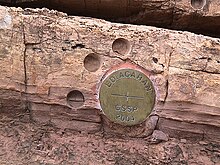Ediacaran
The Ediacaran period (about 635–541 million years BC), is named after the Ediacara Hills of South Australia. It is the last geological period of the Proterozoic eon. The Edicaran is followed by the Cambrian, the first period of the Palaeozoic.
The period is famous for the first larger-bodied fossils, which are probably the first recorded metazoans. These were impressions or trace fossils, first found in England's Charnwood Forest, Leicestershire.[1][2] Geologists did not know what they had found. It was over 60 years later before fossils from the same period were found in South Australia.[3][4]
The status of the Ediacaran as an official geological period was confirmed in 2004 by the International Union of Geological Sciences (IUGS). This made it the first new geological period declared in 120 years.[5]
The Vendian[change | change source]
The Ediacaran period was previously called the Vendian period. The Vendian period was proposed in 1952 by Russian geologist/paleontologist Boris Sokolov.[6][7] The term Vendian is still widely used.
The two terms are not the same. The Vendian was a longer period: it included the whole of the Marinoan glaciation, of Snowball Earth fame. In other words, the Vendian included the last part of the Cryogenian period.
Borders of the Ediacaran[change | change source]

The Ediacaran lasted for about 90 million years. It began at the end of the Cryogenian Snowball Earth. It ended with the first appearance worldwide of some kinds of trace fossils (Treptichnus pedum) at the base of the Cambrian.[8] The Ediacaran period's start is defined at the base of a carbonate layer, referred to as a "cap carbonate". This caps glacial deposits and shows a sudden climatic change at the end of the Marinoan ice age. The period ended with the mass extinction of almost all the Ediacaran fauna.
No exact dating has been possible at the type section of the Ediacaran period in South Australia.
Ediacaran biota[change | change source]
The Ediacaran biota include the oldest definite multicellular organisms. The fossils are traces or impressions of soft-bodies forms with segments, fronds, disks, or bags. Skeletons or shells are not found.
References[change | change source]
- ↑ Hill E & Bonner T.G. 1877. The PreCarboniferous rocks of Charnwood Forest. Q.J. Geol Soc. 33, 754-789.
- ↑ Bottjer, David J. 2002. Enigmatic Ediacara fossils: ancestors or aliens? In Bottjer et al. (eds) Exceptional fossil preservation: a unique view on the evolution of marine life. Columbia, N.Y.
- ↑ Sprigg R.C. 1947. Early Cambrian (?) jellyfish from the Flinders Ranges, South Australia. Trans Roy Soc South Australia 71, 212-224.
- ↑ Glaessner M.F. 1984. The dawn of animal life: a biohistorical study. Cambridge.
- ↑ Knoll A.H. 2002. A new period for the geologic time scale. Science 305, 621.
- ↑ Sokolov B. (1952). "On the age of the old sedimentary cover of the Russian Platform". Izvestiya Akademii Nauk SSSR, Seriya Eologicheskaya. 5: 21–31.
- ↑ Sokolov B. 1997. Essays on the advent of the Vendian System. KMK Scientific Press, Moscow. (in Russian)
- ↑ A. Knoll et al 2004. The Ediacaran period: a new addition to the geologic time scale.International Commission on Stratigraphy.
